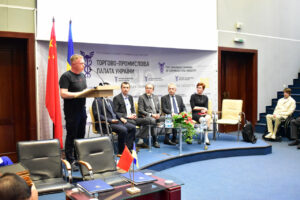
The State Service for Food Safety is making efforts to open the Chinese market to Ukrainian flour in 2025, according to Vadym Chaykovsky, Deputy Head of the State Service for Food Safety and Chief Phytosanitary Inspector of Ukraine.
“We plan to sign protocols with our Chinese colleagues this year to open the market for Ukrainian wheat flour,” he said at the Agro Ukraine Summit in Kyiv on Friday.
He recalled that the State Service initiated procedures to promote the supply of wheat, millet, and sorghum from Ukraine to the Chinese market and is systematically working to open this market for Ukrainian peas.
Chaikovsky added that the phytosanitary authorities of both countries are currently preparing to launch a service such as video inspection of crops from the fields of enterprises that intend to supply products to China in the 2025/2026 season.
The chief phytosanitary inspector called on export-oriented enterprises to promptly contact the regional offices of the State Service of Ukraine for Food Safety and Consumer Protection to conduct phytosanitary inspections of their fields.

The Ukrainian Chamber of Commerce and Industry, together with the Belt and Road Trade and Investment Promotion Center in Ukraine, organized a bilateral business event.
The event, held on May 22, 2025, brought together hundreds of representatives of Ukrainian and Chinese companies interested in establishing direct cooperation at the Ukrainian Chamber of Commerce and Industry.

“China remains Ukraine’s main trading partner. Despite the distance, complex logistics, and tensions, cooperation between companies continues. This is because many sectors of the Ukrainian economy need affordable Chinese imports. And the Chinese market needs Ukrainian products. I hope that the business dialogue will be a prelude to deeper mutual understanding at all levels,” said Gennady Chizhikov, President of the Ukrainian Chamber of Commerce and Industry, during the opening of the forum.

The Chinese delegation included representatives of 11 Chinese companies. Among them were manufacturers of building materials and thermal insulation solutions; packaging and food equipment; consumer electronics and household goods; pharmaceutical products, electric vehicles, rehabilitation equipment, and prosthetics; companies providing logistics, tourism, consulting services, green energy, and agricultural technology.

Business representatives took part in B2B negotiations with potential partners. Chinese entrepreneurs expressed interest in investment activities in most sectors of Ukraine’s economy.
Interfax-Ukraine is the information partner of the forum.

On June 1, 2025, the Agreement on the mutual abolition of visas between Uzbekistan and China will come into force.
Under the Agreement, citizens of the Parties shall be exempt from visa requirements for entry, exit, or transit through the territories of both countries for a period of up to 30 days for each separate stay and a total of up to 90 days within any 180-day period.
At the same time, the period of each entry and stay in the territory of the Parties shall not exceed 30 days.
The visa-free regime does not apply to employment, study, media activities, or other activities that require prior approval by the competent authorities of the other Party.

Imports of transformers, inductors, and chokes to Ukraine in January-April 2025 increased 2.5 times compared to the same period in 2024, reaching $338 million, according to statistics from the State Customs Service.
According to published data, during this period, products were imported mainly from China, worth $279 million (82.5% of all imports of these goods), while a year earlier, transformers and chokes worth $66.1 million (48.4%) were imported from this country, i.e., imports increased 4.2 times.
In addition, transformers were imported from Germany ($17.4 million) and Turkey ($13.9 million), while in January-April 2024, imports from Turkey amounted to $37.1 million, and from Italy – almost $5 million. In particular, in April, imports of this equipment increased by 50% compared to the same month last year, but decreased by 22.3% compared to March this year, to $55.2 million. China’s share was 48.7%.
At the same time, Ukraine exported transformers, inductors, and chokes worth $8.37 million in the first four months of this year, compared to $5.64 million last year, mainly to Germany, Hungary, and Poland.
According to the State Customs Service, imports of transformers, inductance coils, and chokes in 2024 more than doubled compared to 2023, reaching $596.11 million, with imports from China increasing 2.5 times to $400.48 million.